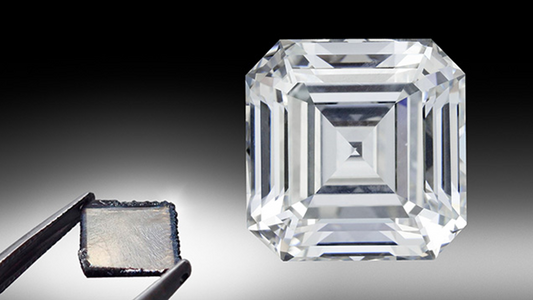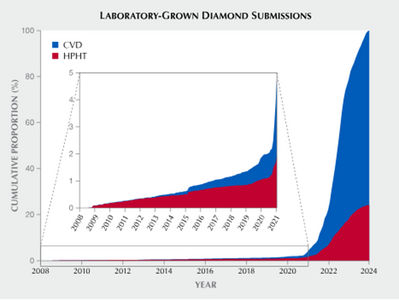- Joined
- Jul 27, 2009
- Messages
- 4,097
Laboratory grown diamonds are produced in highly controlled environments, but they don’t always turn out exactly the way the grower would like. In many cases their appearance can be improved by post-growth treatment. This is usually done to remove color, thereby making the diamond more ‘colorless”, and this is achieved mainly by High Pressure High Temperature (HPHT) treatment. (There are several other treatments used on fancy color lab diamonds including irradiation.)

There are two distinct growth methods used to produce lab grown diamonds - HPHT and CVD. A large majority of the lab diamonds on the market today are CVD grown and approximately 80% of them require post-growth treatment to remove or reduce brown coloration caused by dislocations in the carbon lattice, atomic vacancies, impurities, strain or other defects. Because post-growth treatment is much more accepted in the consumer market for lab grown diamonds, CVD growers have found that they can grow more diamonds more quickly (reducing costs), and although this results in brown material, they know they can then treat the color in a separate process to improve appearance and commercial value. The net result is a win for the growers.

Image courtesy of GIA – Chart based on submissions to GIA
Both HPHT and CVD diamonds, as well as natural diamonds, can potentially be improved by HPHT treatment. Interestingly, while the equipment used to produce HPHT diamonds is the same, the pressures, temperatures and procedures are different for treatment vs growth. The temperatures at which treatment is done are usually substantially higher than that used in the growth process.
Gemological laboratories like GIA and IGI can easily separate lab grown diamonds from natural diamonds, HPHT from CVD grown diamonds, and in most cases diamonds that have received post-growth treatment from those that have not (aka “as grown”). On diamond reports you will normally see these distinctions noted; if not the precise treatment (usually HPHT), a statement to the effect that the diamond may have been treated. The term “As Grown” appearing on a report would mean that no post growth treatment has been done.
Marketplace Acceptance of Treatments - A Tale of Two Different Products
Shoppers in the market for natural diamonds avoid color treatments like the plague! This stigma is decidedly less common among buyers of lab grown diamonds. And while you hear lab diamonds referred to as “exactly the same” as natural diamonds, they are clearly not the same in some important respects.
One may ask, why does post-growth treatment matter if the diamond is lab grown in the first place? To some people, it doesn’t. To others, getting an “As Grown” diamond of high quality is an indication that the process to produce the diamond was perfect, making it more exclusive. It also negates any worries that the treatment process might not have been completely successful or that there are any negative effects on the diamond from the treatment.
While many shoppers considering lab grown diamonds seem to buy into the logic that since this is a manufactured product, it is irrelevant how many steps there are in the manufacturing process. What matters to them is the final product. On the other side of the issue are those shoppers who strongly prefer a high quality “as grown” diamond that didn’t have to be “fixed”. With more shoppers today buying lab grown diamonds for engagement rings or to commemorate other sentimental occasions, emotion does come into the calculus. And the purity of the process becomes an important aspect of their view of quality and value.
What does it say about the difference between lab grown diamonds and natural diamonds that far more shoppers accept treatments to decolorize labs or to otherwise enhance their appearance? Would love to hear your thoughts!

There are two distinct growth methods used to produce lab grown diamonds - HPHT and CVD. A large majority of the lab diamonds on the market today are CVD grown and approximately 80% of them require post-growth treatment to remove or reduce brown coloration caused by dislocations in the carbon lattice, atomic vacancies, impurities, strain or other defects. Because post-growth treatment is much more accepted in the consumer market for lab grown diamonds, CVD growers have found that they can grow more diamonds more quickly (reducing costs), and although this results in brown material, they know they can then treat the color in a separate process to improve appearance and commercial value. The net result is a win for the growers.

Image courtesy of GIA – Chart based on submissions to GIA
Both HPHT and CVD diamonds, as well as natural diamonds, can potentially be improved by HPHT treatment. Interestingly, while the equipment used to produce HPHT diamonds is the same, the pressures, temperatures and procedures are different for treatment vs growth. The temperatures at which treatment is done are usually substantially higher than that used in the growth process.
Gemological laboratories like GIA and IGI can easily separate lab grown diamonds from natural diamonds, HPHT from CVD grown diamonds, and in most cases diamonds that have received post-growth treatment from those that have not (aka “as grown”). On diamond reports you will normally see these distinctions noted; if not the precise treatment (usually HPHT), a statement to the effect that the diamond may have been treated. The term “As Grown” appearing on a report would mean that no post growth treatment has been done.
Marketplace Acceptance of Treatments - A Tale of Two Different Products
Shoppers in the market for natural diamonds avoid color treatments like the plague! This stigma is decidedly less common among buyers of lab grown diamonds. And while you hear lab diamonds referred to as “exactly the same” as natural diamonds, they are clearly not the same in some important respects.
One may ask, why does post-growth treatment matter if the diamond is lab grown in the first place? To some people, it doesn’t. To others, getting an “As Grown” diamond of high quality is an indication that the process to produce the diamond was perfect, making it more exclusive. It also negates any worries that the treatment process might not have been completely successful or that there are any negative effects on the diamond from the treatment.
While many shoppers considering lab grown diamonds seem to buy into the logic that since this is a manufactured product, it is irrelevant how many steps there are in the manufacturing process. What matters to them is the final product. On the other side of the issue are those shoppers who strongly prefer a high quality “as grown” diamond that didn’t have to be “fixed”. With more shoppers today buying lab grown diamonds for engagement rings or to commemorate other sentimental occasions, emotion does come into the calculus. And the purity of the process becomes an important aspect of their view of quality and value.
What does it say about the difference between lab grown diamonds and natural diamonds that far more shoppers accept treatments to decolorize labs or to otherwise enhance their appearance? Would love to hear your thoughts!







300x240.png)